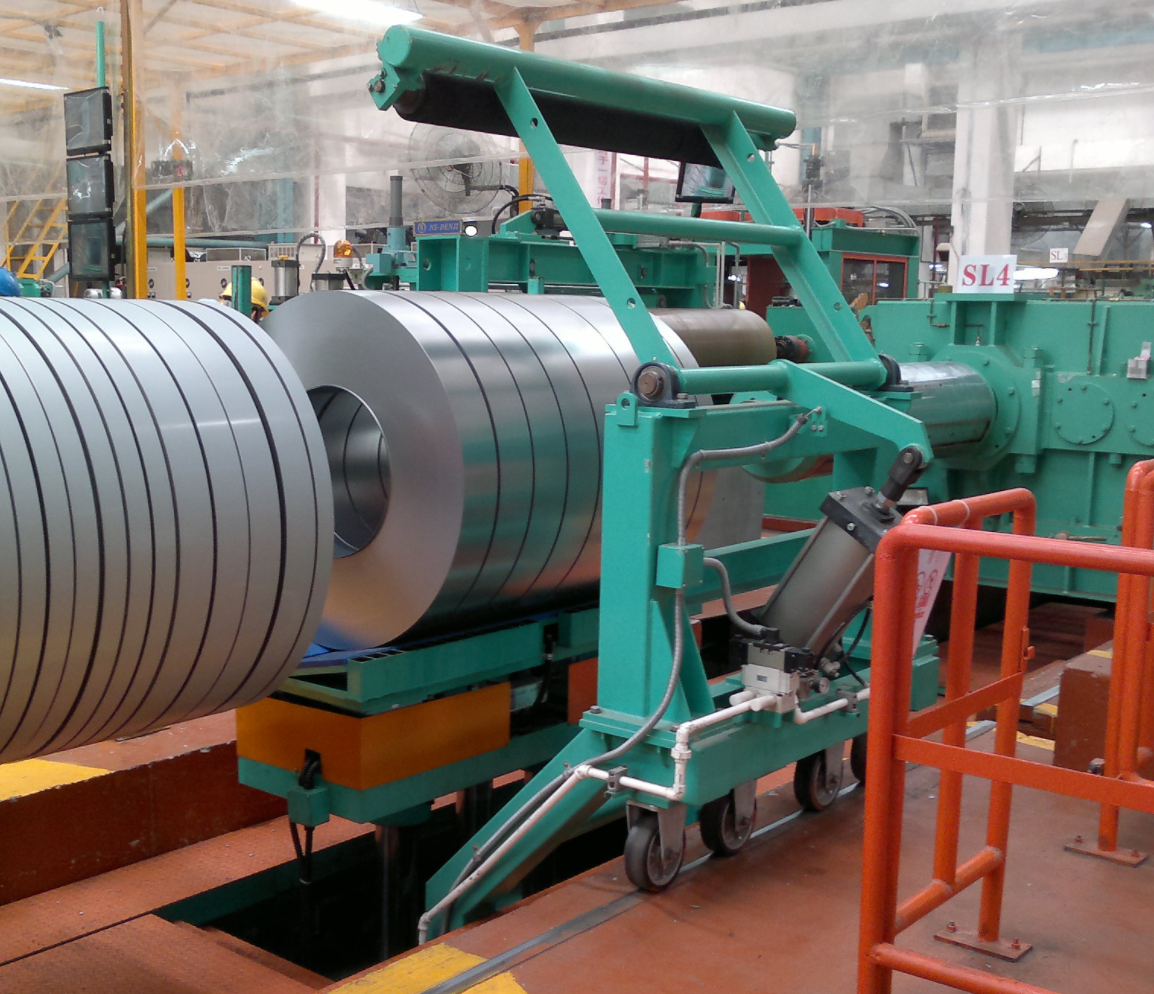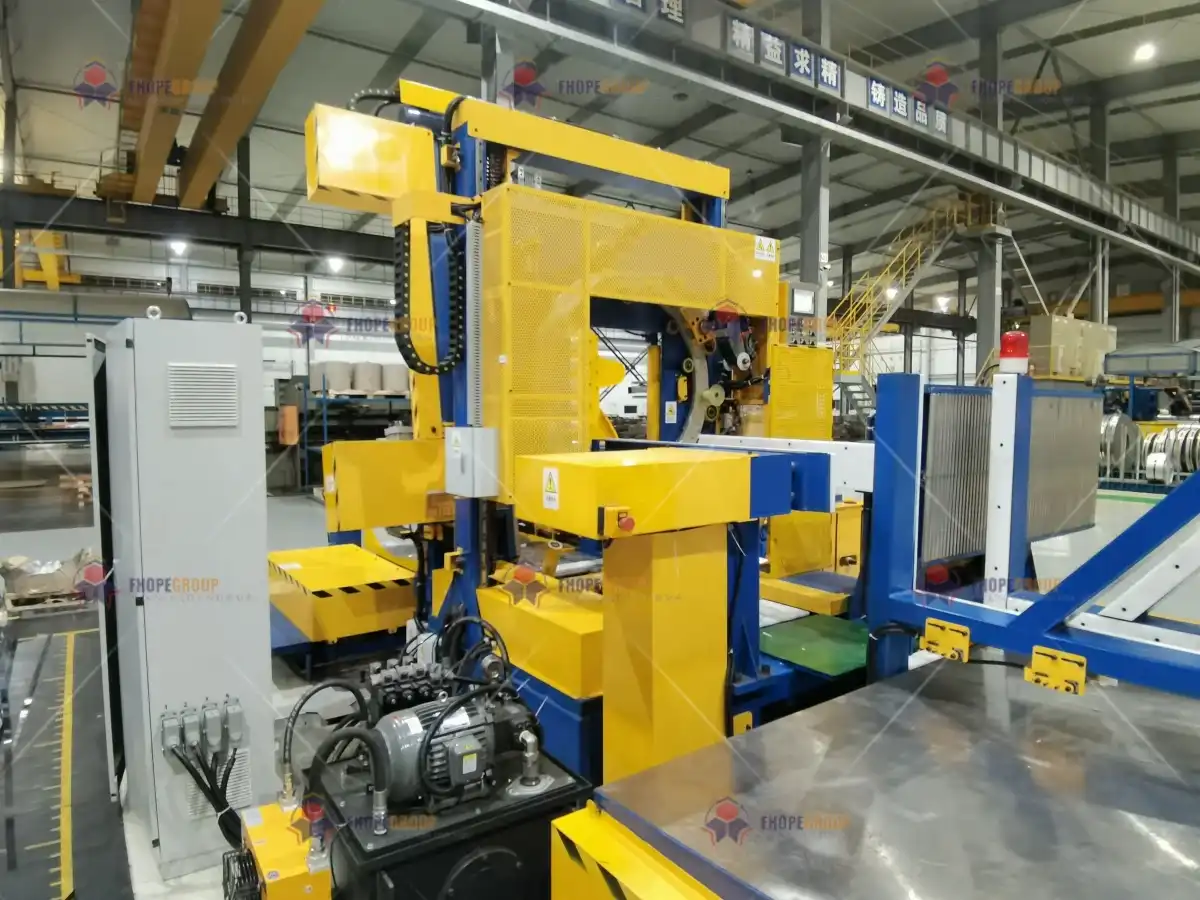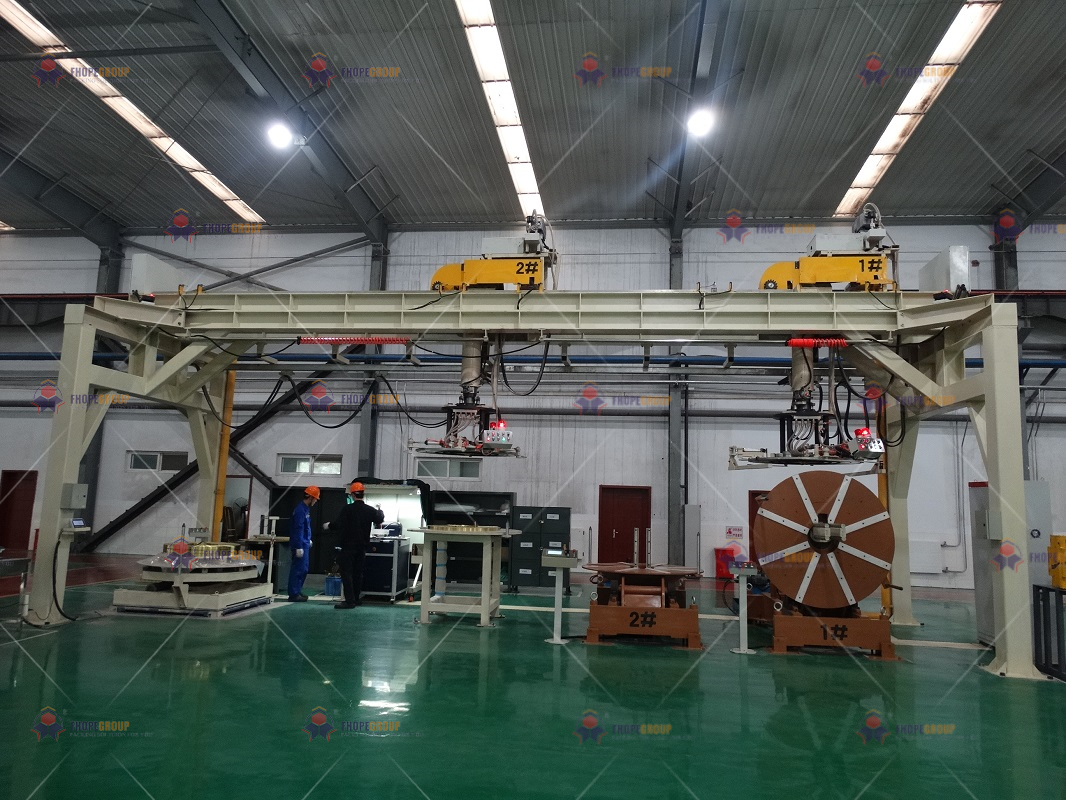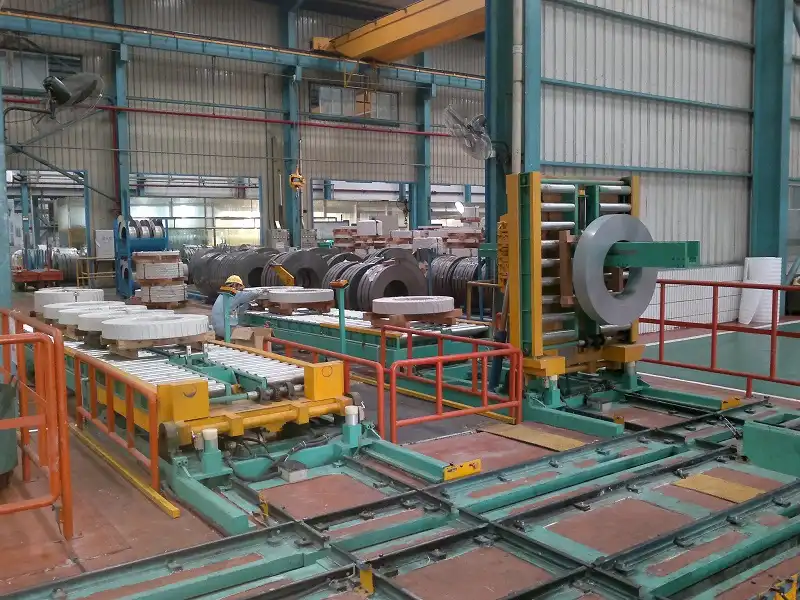In today's global steel market, the journey from your mill to the customer is longer and more perilous than ever. For a steel producer in Malaysia, exporting to Europe, the Americas, or anywhere else means your product will spend weeks at sea. It will face humidity, salt spray, and rough handling. I’ve seen firsthand how a mill can do everything right—perfect chemistry, precise rolling, flawless quality control—only to have the product arrive rusted or damaged. This leads to costly customer claims, endless paperwork, and worst of all, a damaged reputation. It's a constant worry that undermines your hard work and profitability. The manual or semi-automatic packing methods that work for domestic sales just aren't enough to protect your steel and your brand on the world stage.
To achieve true export-grade protection for steel coils heading into the global market from Malaysia, mills must adopt a fully automatic coil packing line. This system provides a multi-layered defense. It uses specialized materials like VCI paper to prevent corrosion and high-tension stretch film to create a waterproof, durable shield. By automating the entire process, from handling to wrapping and strapping, it guarantees that every coil receives the same high level of consistent, reliable protection needed to survive long-distance sea freight and arrive in perfect condition.

This isn't just about wrapping steel better. It's about building a fortress around your product. It’s about giving your customers the confidence that when they order from you, they get exactly what they paid for, every single time. For a leader like Javier Morales, a steel mill owner who analyzes every investment for its return and stability, this is not a cost center. It is a critical component of quality assurance and a strategic investment in the company's future. But how does this automation solve the day-to-day problems on the factory floor? And what does it really mean for your bottom line? Let's break down the real-world impact.
How does automation solve the high labor cost and inconsistency in manual packing?
Relying on a manual packing team creates two major headaches: high costs and inconsistent quality. You have a team of operators working in shifts around the clock. Their wages, benefits, and training are a significant and rising operational expense, especially in a growing economy like Malaysia. But the bigger problem is inconsistency. A worker on a Monday morning is sharp and focused. That same worker at the end of a long, hot shift might rush a job. The wrapping tension might be too loose, or the overlap on the film might be insufficient. These small mistakes, invisible at your dock, become huge problems when the coil is unwrapped thousands of miles away.
Automation directly solves these issues by replacing repetitive, manual tasks with precise, programmable machinery. This drastically cuts the number of operators needed to run the packing line, leading to immediate and significant labor cost savings. More importantly, it eliminates human error and variability. An automatic system applies the exact same wrapping tension, material overlap, and strap placement for every single coil, 24/7. This ensures a consistent, high-quality, and reliable package that protects the product as designed, every time.

The True Cost of Manual Operations
When I talk to mill owners, they often focus only on the salary line item for their packing crew. But the true cost of manual packing is much higher. It's a collection of direct and hidden expenses that eat away at your profit margin. An automatic line transforms these costs into savings and predictable outcomes. A forward-thinking leader like Javier, who aims to cut overall operating costs by 8%, would immediately see the value in this shift. Let's look at a realistic comparison.
| Metric | Manual Packing | Automatic Packing Line | Impact on Operations |
|---|---|---|---|
| Labor Requirement | 3-5 operators per shift | 1 supervisor per shift | Drastic reduction in direct labor costs and associated overhead. |
| Throughput | 8-10 coils per hour (max) | 15-25 coils per hour | Increased capacity without adding headcount; meets production spikes. |
| Material Consumption | High variability, often >20% waste | Precise, controlled use, <5% waste | Significant savings on consumables like stretch film and paper. |
| Packing Quality | Inconsistent; depends on operator | 100% consistent and repeatable | Eliminates claims due to packing errors; builds brand trust. |
| Worker Safety | High risk of strains, cuts, falls | Minimal physical interaction | Lower insurance premiums and fewer lost-time incidents. |
| Data Tracking | Manual, paper-based, error-prone | Automatic, real-time to MES/ERP | Provides valuable data for process optimization and traceability. |
From Inconsistency to Ironclad Guarantee
Inconsistency is the enemy of any industrial process, especially in an export-driven business. A single improperly wrapped coil that arrives rusted can trigger a chain reaction. First, there's the direct cost of the claim. Then, there's the administrative cost of handling the dispute. Your sales team has to spend time placating an unhappy customer instead of generating new business. Your logistics team is tied up. Your brand reputation takes a hit. The customer might start looking for a more reliable supplier for their next order. Automation turns this liability into a strength. When your packing is automated, you can provide an ironclad guarantee of protection. It becomes a selling point, a reason for global buyers to choose you over a competitor who still relies on manual methods.
What specific materials and techniques ensure protection during sea freight?
Your steel coil is going on a long, tough journey. For weeks, it will sit in the hold of a cargo ship, a metal box surrounded by humid, salty air. The temperature will swing wildly from day to night, causing condensation—"sweat"—to form on the steel surface. This environment is a perfect recipe for rust and corrosion, especially for sensitive products like galvanized or cold-rolled steel. Simply wrapping it in a layer of plastic is like bringing a knife to a gunfight. You need a specialized defense system designed for this exact challenge.
To truly protect steel during sea freight, a multi-material strategy is required, applied with precise techniques. The core of this strategy is the use of Volatile Corrosion Inhibitor (VCI) paper or film. This material releases a harmless, invisible vapor that forms a protective molecular layer over the steel, actively preventing rust. This is then overwrapped with a high-performance, waterproof stretch film. The automatic wrapper applies this film with high tension and a specific overlap percentage, creating a tight, sealed cocoon that acts as a physical barrier against moisture, salt, and dirt.

A Layer-by-Layer Defensive System
Think of export packing not as a single action, but as building layers of defense. Each layer has a specific job, and they work together to provide complete protection. I always explain it to clients as a system, because the strength of the whole depends on each part being done correctly. This is where automation shines, as it executes each step perfectly.
| Packing Layer | Material Used | Primary Function | Why Automation is Critical |
|---|---|---|---|
| 1. Inner Shield | VCI Paper / VCI Film | Active Corrosion Prevention. Releases vapor that stops the chemical reaction of rust from starting on the metal surface. | Ensures complete and even coverage, especially in the hard-to-reach inner eye of the coil. Manual application can leave gaps. |
| 2. Moisture Barrier | LLDPE Stretch Film | Waterproofing and Stability. Creates a tough, puncture-resistant, waterproof barrier. The high tension compacts the package. | Applies the film with consistent, high tension and a precise overlap (e.g., 50%) to create a hermetic seal. Manual wrapping can't achieve this tension. |
| 3. Structural Integrity | PET / PP Strapping | Securing the Package. Keeps the wrapping materials firmly in place and prevents the coil from shifting or the packaging from coming loose. | Applies straps with uniform tension at exact, pre-programmed locations without damaging the coil edges. |
| 4. Impact Protection | Corner/Edge Protectors | Physical Damage Prevention. Protects the vulnerable edges of the coil from being dented or damaged during handling and transit. | Automatic applicators place protectors accurately before the final strapping, ensuring they are in the right position every time. |
Application Technique is Everything
Having the right materials is only half the battle. How they are applied is just as important. For example, the stretch film must be applied with enough tension to "lock" the layers together and squeeze out any trapped air. The overlap between revolutions of the film must be perfect to ensure there are no small gaps where moisture can penetrate. The "eye" of the coil—the center hole—must be thoroughly wrapped and sealed, as this is a common point of failure. A manual crew simply cannot replicate the precision and power of a machine, shift after shift. An automatic wrapper controls these variables with digital accuracy. This is the difference between hoping your product is safe and knowing it is. For a leader like Javier, who is obsessed with quality control, this level of process control is non-negotiable.
How does an automatic packing line integrate with existing mill systems like MES?
Your steel mill is becoming smarter. You've likely invested in a Manufacturing Execution System (MES) or an ERP to track production from the furnace to the rolling stand. This gives you valuable data and visibility. But often, the packing area remains a "data black hole." Information is recorded on paper, entered manually into a terminal, and is often slow and full of errors. This disconnects the final, critical step of your process from your digital ecosystem, undermining your goal of a fully visualized and efficient operation.
A modern automatic packing line is designed to be a smart, communicative part of your factory. It integrates seamlessly with your MES or plant-level control systems using standard industrial protocols like Profinet, Ethernet/IP, or OPC-UA. The packing line’s brain, its PLC, can receive packing instructions directly from the MES for each specific coil. In return, it sends back a wealth of real-time data, including cycle times, material consumption, weight, and a confirmation that the coil is packed and ready for shipping. This closes the data loop, making your packing area fully visible and controllable.

Creating a Seamless Data Flow
The integration process transforms your packing station from an isolated island into a vital node in your information network. For a CEO like Javier, who is pushing a digital transformation agenda, this is a critical step toward achieving 100% production visibility. The data flow is logical and powerful.
- Instruction from MES: As a coil arrives at the packing line, its unique ID is scanned. The MES automatically sends a "packing recipe" to the line's PLC. This recipe contains all the necessary information: coil dimensions, customer requirements, number of VCI wraps, number of stretch film layers, and strapping pattern.
- Execution by the Line: The automatic line executes the recipe perfectly without any operator input.
- Real-Time Monitoring: Sensors on the machine track every detail. They measure the exact amount of stretch film and VCI paper used. They count the number of straps applied. This data is displayed on the line's HMI and is available to the control room.
- Data Feedback to MES: Once the cycle is complete, the packing line sends a confirmation back to the MES. This data packet includes the coil ID, a timestamp, total material consumption, and a "packed and ready" status. The MES now has a complete, accurate, digital record of the finished product. An automatic label printer can then produce a final shipping label with all the correct information.
Leveraging Data to Achieve Key Goals
This integration is not just for the IT department. It provides tangible operational benefits that directly support the strategic goals of the entire plant.
| Strategic Goal (from Javier's Profile) | How MES Integration Helps |
|---|---|
| Improve产能利用率 (Increase Uptime to 95%) | The PLC tracks machine cycles and motor hours. This data can be used for predictive maintenance alerts, allowing you to service the machine before it fails, avoiding unplanned downtime. |
| 降低单位能耗 (Reduce Unit Energy Cost) | While the line itself is not a major energy user, tracking its operational efficiency helps. By ensuring smooth, continuous flow, you avoid the energy waste of stop-start operations. |
| 推进数字化转型 (Drive Digital Transformation) | This is the very definition of digitalization. It connects a physical process to the digital system, eliminating manual data entry and providing a single source of truth for finished goods inventory. |
| 提升利润率 (Improve Profit Margin by 8%) | Precise material tracking from the sensors allows you to optimize consumable usage, reducing waste. Accurate data eliminates costly errors from mislabeled or lost coils. |
This level of integration is what separates a machine supplier from a strategic partner. As engineers at SHJLPACK, we understand both the automation and the data side. We work with our clients' IT and engineering teams to ensure the handshake between our machine and their system is perfect.
What is the realistic ROI for an automatic coil packing line in the Malaysian context?
As a business owner, every major capital expenditure comes down to one question: what is the return on my investment? Looking at the price of a fully automatic packing line can feel intimidating. It’s a significant upfront cost. I’ve had many conversations with factory managers and owners who are hesitant, focusing only on that initial number. But this is the wrong way to look at it. The real question is, what is the cost of not automating? You are already spending money every single day on high labor costs, wasted materials, and the occasional—but very expensive—customer claim for damaged goods.
The realistic Return on Investment (ROI) for an automatic coil packing line in a market like Malaysia is typically between 24 and 36 months. This rapid payback is driven by a powerful combination of "hard" and "soft" savings. The hard savings are quantifiable and immediate: a dramatic reduction in the labor force needed for packing, a 15-20% reduction in consumable material costs due to precise application, and the virtual elimination of financial losses from product damage claims. The soft savings, like enhanced brand reputation and increased customer trust, further accelerate the long-term value.

Deconstructing the ROI Calculation
To understand the ROI, we need to look at both sides of the ledger: the one-time investment and the ongoing, monthly savings. For a practical leader like Javier, a clear, data-driven business case is essential. He needs to see the numbers. Let’s create a simplified model based on a typical Malaysian steel service center or mill.
The Investment (One-Time Cost):
- Automatic Packing Machine: The main capital expense.
- Installation & Commissioning: Engineering support to get the line running.
- Training: Teaching your team to operate and maintain the system.
The Returns (Monthly Savings & Gains):
| Savings Category | Manual Packing (Monthly Cost) | Automatic Packing (Monthly Cost) | Monthly Savings |
|---|---|---|---|
| Labor Costs | 4 operators/shift x 3 shifts = 12 operators. (Assume RM 3,000/operator avg.) = RM 36,000 | 1 supervisor for all shifts (higher skill). = RM 5,000 | RM 31,000 |
| Material Waste | 20% waste on stretch film/paper. (Assume RM 50,000 material cost) = RM 10,000 | 5% waste due to precise control. = RM 2,500 | RM 7,500 |
| Damage Claims | Avg. 1 claim/quarter at RM 100,000. = ~RM 33,000/month | Eliminated. = RM 0 | RM 33,000 |
| Total Monthly Savings | ~RM 71,500 |
This is a simplified model, but it shows how quickly the savings add up. If the total investment for the line is, for example, RM 1.8 million, the payback period would be approximately RM 1,800,000 / RM 71,500 ≈ 25 months. This falls squarely within the 2-3 year ROI timeframe.
The Strategic Value Beyond the Spreadsheet
The numbers are compelling, but for a forward-thinking owner, the strategic value is just as important. An automatic packing line is not just a cost-cutting tool; it's a reputation-building machine. When you can guarantee to your international customers that every coil will arrive in pristine condition, you become a preferred supplier. You are no longer competing on price alone; you are competing on quality and reliability. This investment directly addresses Javier's core challenges: it reduces operational costs to fight margin pressure, it improves stability by removing human inconsistency, and it uses technology to create a competitive advantage in a tough market. It’s an investment in peace of mind.
My Insights
When I look at a profile like Javier Morales, I see a reflection of my own journey. I started as an engineer on the factory floor, and I understand the immense pressure to balance production goals, cost control, and long-term strategy. Javier is facing challenges that are universal in the steel industry: volatile energy prices, aging equipment, and constant pressure on margins. He’s not looking for a simple machine vendor; he’s looking for a partner who understands his world.
The proposal for an automatic coil packing line isn't about adding another piece of equipment to his list of assets. It's about strategically solving several of his key problems at once. His equipment is aging and failure rates are rising. An automatic packing line replaces what is often one of the most manually intensive and unreliable parts of the entire production chain with a new, robust, and highly reliable system. This directly contributes to his goal of 95% uptime, at least for the critical final stage of his process.
He's also driving a digital transformation. The packing line we've discussed isn't a dumb machine; it's a smart, data-rich node that plugs directly into his MES. It provides the visibility he needs to make better decisions. This isn't just a "nice to have"; it's essential for achieving the 8% reduction in operational costs he's targeting. You can't manage what you can't measure, and this gives him the data to manage his finished goods and packing consumables with precision.
I built SHJLPACK on the principle of being a "TOTAL SOLUTION" provider because I know that leaders like Javier don't just buy machines. They invest in outcomes. They need a partner who will be there for the selection, the installation, the integration with their existing systems, and the long-term support. My experience has taught me that true success comes from helping my clients succeed. By sharing my knowledge, I hope to give back to the industry that has given me so much and help other passionate engineers and business owners build stronger, more profitable companies.
Conclusion
Automating your coil packing is not an expense; it is your passport to the global market. It guarantees protection, builds customer trust, and secures your brand's reputation for quality.





